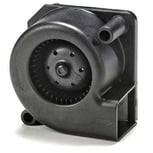What is Manual Variable Resistance Control?
 Applications that require excellent efficiency in high-power, high-voltage conditions require sophisticated control options. Manual variable resistance control maximizes performance and reliability in applications requiring manual speed control at variable levels.
Applications that require excellent efficiency in high-power, high-voltage conditions require sophisticated control options. Manual variable resistance control maximizes performance and reliability in applications requiring manual speed control at variable levels.
Manual variable resistor control (RPWM) technology uses an external variable resistor to manually control the fan speed in linear relation to the resistor value. This type of control is crucial for a variety of applications, including welding controls, control for generators, DC motor drives, and more.
Using Advanced Technology for Manual Variable Resistance Control
Utilizing advanced technology for manual variable resistance control provides a greater degree of reliability and performance. Tools like variable resistors, also known as potentiometers, can provide insight into your motor's performance by comparing its electromotive force (emf) against a known emf standard. Along with this insight, a number of control options can also be included when using manual variable resistance control, including constant speed, inrush current protection, and current limits.
Constant Speed (CS)
This control is set externally to keep devices such as motors running at a constant speed. CS is attained by monitoring the applied voltage and the current to the motor.. The values of these factors are calculated and the speed is adjusted to remain constant to ensure the desired maximum RPM and noise level. If the applied voltage is increased, the applied current will decrease, maintaining the power of the motor constant. Using constant power technique, the safe operation of the motor is ensured when the applied voltage exceeds the rated value.
Inrush Current Protection (IR)
To avoid gradual damage to components and tripping circuit breakers or fuses, manual variable resistor controls implement IR. The current is applied gradually to the motor when the motor is powered up.
Current Limit (CL)
Similar to IR, this limit is important for protecting the circuit of the device from the effects of short-circuiting or other overload problems. This is often accomplished by using a fuse; however, in the case of electronic power circuits, active current limiting is employed instead due to their faster response. Circuitry is arranged to create a protective mechanism that prevents overloading damage during operation.
RPWM technology is available in three different modes: A, B, and C. Selection of the appropriate mode for a specific application depends on resistor value and percentage.
Types of Variable Resistors
There are multiple types of variable resistors, including potentiometers, rheostats, and digital resistors.
Potentiometer
This type of variable resistor is extremely common. They have three terminals and can tune and calibrate circuits, be a potential divider, and generate voltage signals. The voltage signal has many different potential applications including:
- Measuring distance
- Measuring angles
- Controlling amplifier gain (audio volume)
- Tuning circuits
For tuning or calibrating a circuit, trimpots or trimmer potentiometers are used. These smaller potentiometers can be mounted onto a circuit board and adjusted with a screwdriver.
Rheostat
Rheostats are very similar to potentiometers. However, they operate by providing variable resistance instead of acting as a potential divider. They have two terminals, one connected to the end of the resistive components and the other at the variable resistor's wiper.
Today's rheostats are most commonly used in circuitry systems as variable resistors. They perform tuning and calibration for circuits, rather than the power control they used to provide in previous generations. While rheostats were historically used as power control components for lights and other electrical systems, they're now regarded as too inefficient for power control and have been replaced by switching components for most applications.
Digital Variable Resistor
Digital resistors provide resistance changes and system regulation through electronic signals instead of mechanical movement. Like other variable resistors, they provide gradual changes to best protect the system and components. Digital resistors use up-down signals and I2C digital protocols to regulate resistance levels.
PTI's Manual Variable Resistance Control Technology
At Pelonis, we design and fabricate all types of high-tech solutions, including those that require RPWM controls. Various applications of our RPWM controlled tools include custom high-efficiency DC fans used throughout the medical industry and other specialty fans and DC blowers. Our products benefit from manual variable resistance control as they protect the moving parts from wear. Our variable resistance control solutions help provide systems with reliable performance, protection from damage, and better longevity.
Choose Pelonis for Manual Variable Resistance Control
Manual variable resistance control is crucial for DC motors and other systems as it ensures optimal reliability and performance. At Pelonis, we strive every day to provide our customers with the best quality and value for custom fan and related technologies. To learn more about how RPWM controls provide enhanced quality, efficiency, and lifespan for your high-tech applications, download our eBook, Fan Speed Controls. For more information about our capabilities, contact us today.





